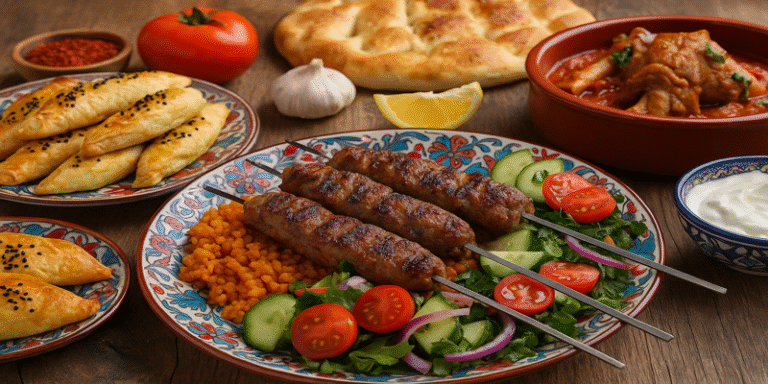Turkish cuisine represents one of the world’s richest and most diverse culinary traditions, shaped by centuries of cultural exchange, geography, and agricultural abundance. Situated at the crossroads of Europe and Asia, Turkey’s food culture reflects a synthesis of Middle Eastern, Mediterranean, Balkan, and Central Asian influences (Çelik & Barcın-Güzeldere, 2025). With its balance of flavour, nutrition, and sustainability, Turkish cuisine continues to captivate global interest.
This article explores the historical roots, cultural depth, nutritional science, and environmental aspects of Turkish foods, referencing scholarly studies, reputable journals, and food science research. It also considers how traditional Turkish dietary patterns align with modern concepts of healthy and sustainable eating.
1.0 Historical and Cultural Roots of Turkish Cuisine
From the Silk Road to the Ottoman Empire
The origins of Turkish cuisine are deeply tied to the migration of Turkic peoples from Central Asia to Anatolia. These early nomads brought with them a diet based on meat, dairy, and grains, which evolved through interaction with Persian, Arab, and Byzantine culinary traditions.
During the Ottoman Empire (1299–1922), Turkish food culture reached its zenith. The empire’s vast reach—from North Africa to the Balkans—allowed the exchange of spices, fruits, vegetables, and cooking methods. This era gave rise to the imperial cuisine of Istanbul, blending regional tastes into sophisticated dishes such as dolma (stuffed vegetables), baklava, and kebabs (Yılmaz-Hava et al., 2024).
Food as Cultural Identity
Food in Turkey is more than sustenance—it is social, spiritual, and symbolic. Shared meals embody hospitality and community, central values in Turkish culture. Coffeehouses, meze culture (shared appetisers), and family-style dining all reinforce a sense of togetherness.
According to Yılmaz-Hava, Zanjer, and Rottmann (2024), Turkish food functions as a resilience practice, preserving identity and cohesion even amid modern pressures like migration and urbanisation.
2.0 Regional Diversity
Anatolia: The Agricultural Heartland
Anatolia, the Asian part of Turkey, has long been known as the “breadbasket of the Mediterranean” due to its fertile plains. Wheat, legumes, olive oil, and vegetables dominate local diets.
In the Southeast, dishes like lahmacun (thin dough topped with minced meat and herbs) and bulgur pilaf showcase the use of grains and spices typical of the region (İçigen & Gençağ, 2025).
The Aegean and Mediterranean Coasts
In western Turkey, especially along the Aegean coast, cuisine is shaped by olive oil, seafood, and fresh herbs—closely resembling the Mediterranean diet (Altundağ & Samav, 2024).
Salads, legumes, and vegetable-based dishes such as zeytinyağlı enginar (artichokes in olive oil) are central to everyday meals.
The Black Sea Region
In contrast, the Black Sea region relies heavily on corn, anchovies (hamsi), and leafy greens. This region’s cuisine reflects a blend of mountain and maritime influences, showing Turkey’s geographical and ecological diversity (Çelik & Barcın-Güzeldere, 2025).
3.0 Nutritional and Functional Aspects
Balanced Nutrition
Traditional Turkish diets are naturally balanced, combining plant-based foods, moderate animal proteins, and healthy fats.
Common ingredients such as lentils, chickpeas, olive oil, yoghurt, grains, and vegetables offer essential micronutrients, antioxidants, and fibre, making Turkish food both tasty and therapeutic (Altundağ & Samav, 2024).
Recent research by Çelik and Barcın-Güzeldere (2025) has demonstrated that regional Turkish diets have lower carbon and water footprints than Western-style diets, without compromising nutritional quality. The study shows that legume-based meals, traditional in Anatolia, are both nutrient-dense and environmentally sustainable.
Functional Foods and Spices
Turkish cuisine is also rich in functional ingredients—foods that offer health benefits beyond nutrition.
For example:
- Garlic and onions aid cardiovascular health.
- Cumin, sumac, and turmeric have anti-inflammatory properties.
- Yoghurt provides probiotics for digestive health.
- Herbs such as mint and thyme contribute antioxidants.
Altundağ and Samav (2024) emphasise that traditional Turkish use of spices and herbs plays a vital role in preventing chronic diseases while enhancing flavour naturally—an ancient form of functional nutrition.
4.0 Health Benefits and Longevity
Several studies suggest that traditional Turkish diets support heart health, metabolic balance, and longevity, much like the Mediterranean diet (Çelik & Barcın-Güzeldere, 2025).
Typical meals—such as lentil soup, stuffed vegetables, grilled fish, and olive-oil-based salads—provide a nutrient-rich, low-saturated-fat pattern.
Moreover, the communal and slow-paced nature of Turkish eating aligns with mindful eating principles, reducing overeating and stress (Yılmaz-Hava et al., 2024).
5.0 Sustainability in Turkish Food Systems
Traditional Agricultural Wisdom
Turkey’s diverse climate and geography enable sustainable crop rotation and mixed farming.
Legumes, in particular, play a key ecological role in nitrogen fixation, improving soil health and reducing reliance on chemical fertilisers.
According to İçigen and Gençağ (2025), geographically indicated Turkish legumes such as Antep lentils and Bolu beans exemplify regional sustainability—they support biodiversity while preserving culinary heritage.
Low Environmental Impact
Çelik and Barcın-Güzeldere (2025) explored the carbon and water footprints of Turkish regional cuisines and found that traditional dishes typically have lower environmental impacts than industrialised diets.
They argue that the plant-forward nature of Turkish cuisine, combined with seasonal and local sourcing, makes it a model for sustainable nutrition.
Food Waste and Cultural Practices
Traditional Turkish households value resourcefulness and minimal waste. Leftovers are often transformed into new meals, and local markets encourage seasonal eating.
This cultural habit aligns with modern zero-waste and circular economy principles, demonstrating how ancient wisdom supports modern sustainability (Özkan & Deniz, 2025).
6.0 Modernisation, Globalisation, and Challenges
While traditional foods remain central to Turkish life, urbanisation and globalisation have introduced challenges. Fast food, refined sugars, and processed snacks are increasingly popular among younger generations, contributing to rising obesity rates (Özkan & Deniz, 2025).
However, there is also a resurgence of interest in traditional and regional foods, driven by movements that promote slow food, local agriculture, and organic production. Culinary tourism—focusing on authentic experiences like Gaziantep’s baklava or Hatay’s meze—has helped sustain traditional foodways economically and culturally.
7.0 Turkish Foods in the Global Context
Turkish cuisine has gained global prominence, influencing Middle Eastern and Mediterranean restaurants worldwide. Dishes such as kebabs, hummus, pide (flatbread), and baklava are celebrated internationally.
Yet, beyond its famous dishes, Turkey offers a philosophy of eating grounded in moderation, freshness, and community—values increasingly echoed by global sustainability and wellness movements (Yılmaz-Hava et al., 2024).
Turkish foods embody the harmonious blend of flavour, nutrition, culture, and sustainability. From olive oil-based Aegean dishes to spice-rich Anatolian stews, the cuisine reflects centuries of adaptation and innovation.
Research demonstrates that traditional Turkish diets are not only health-promoting and nutritionally balanced, but also environmentally sustainable—a powerful reminder that culinary heritage can guide future food security and public health (Çelik & Barcın-Güzeldere, 2025).
As global food systems search for balance, Turkish cuisine stands as a bridge between the ancient and the modern, offering both taste and wisdom for a sustainable future.
References
Altundağ, Ö.Ö. & Samav, U. (2024). Türk Mutfağında Kullanılan Baharatların Fonksiyonel Yönü. Turkish Journal of Agriculture-Food Science and Technology, 12(4), pp. 56–69.
Çelik, Z.M. & Barcın-Güzeldere, H.K. (2025). From Plate to Planet: Nutritional and Environmental Sustainability of Turkish Cuisine Across the Regions of Türkiye. Journal of Environmental Health, Taylor & Francis.
İçigen, M. & Gençağ, B.S. (2025). Regional Distribution of Geographically Indicated Dried Legumes and Dried Legume Dishes in Türkiye. Toros University Journal of Food, Nutrition and Gastronomy.
Özkan, A. & Deniz, C. (2025). Effects of the Change in Wheat Varieties as a Result of the Green Revolution on Culinary Culture. Gaziantep Üniversitesi Sosyal Bilimler Dergisi.
Yılmaz-Hava, Z., Zanjer, N. & Rottmann, S.B. (2024). Culinary Sustainability as a Resilience Practice for Syrian Refugees Amidst Urban Precarity in Istanbul. Food, Culture & Society, Taylor & Francis.









